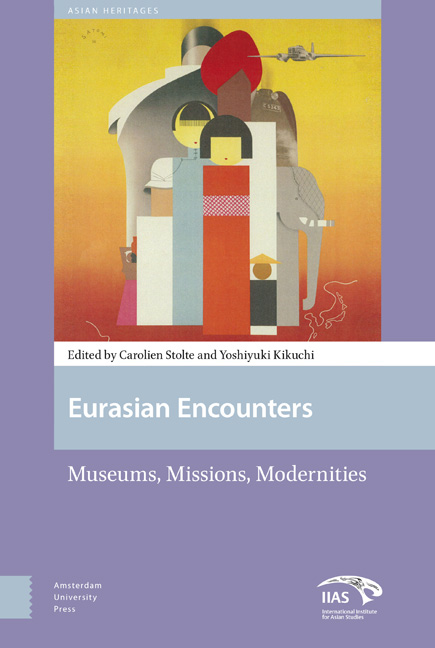Book contents
- Frontmatter
- Contents
- 1 Eurasian Encounters: Cross-border Intellectual and Cultural Exchange, 1900-1950
- Part I Artistic Spaces
- 2 The Museum at Aundh: Reflecting on Citizenship and the Art Museum in the Colony
- 3 Exhibiting the Nation: Cultural Flows, Transnational Exchanges, and the Development of Museums in Japan and China, 1900-1950
- 4 Parallel Tracks: Pan Yuliang and Amrita Sher-Gil in Paris
- 5 Bauhaus and Tea Ceremony: A Study of Mutual Impact in Design Education between Germany and Japan in the Interwar Period
- Part II Missions and Education
- 6 Schooling a Missionary in Early Twentieth-Century Eastern India
- 7 The Catholic Church in China in the First Half of the Twentieth Century: The Establishment of Zhendan University and Furen University
- Part III Shared Trajectories, New Subjectivities
- 8 Indigenizing Cosmopolitanism: Shifting Metropolitan Subjectivities in Twentieth-century Colombo
- 9 Fighting for the Soviet Empire: War Propaganda Production and Localized Discourses on Soviet Patriotism in Uzbekistan during the Second World War
- 10 Shared Origins, Shared Outcomes?: Transcultural Trajectories of Germany and Japan during the Asia-Pacific War
- Index
3 - Exhibiting the Nation: Cultural Flows, Transnational Exchanges, and the Development of Museums in Japan and China, 1900-1950
Published online by Cambridge University Press: 12 December 2020
- Frontmatter
- Contents
- 1 Eurasian Encounters: Cross-border Intellectual and Cultural Exchange, 1900-1950
- Part I Artistic Spaces
- 2 The Museum at Aundh: Reflecting on Citizenship and the Art Museum in the Colony
- 3 Exhibiting the Nation: Cultural Flows, Transnational Exchanges, and the Development of Museums in Japan and China, 1900-1950
- 4 Parallel Tracks: Pan Yuliang and Amrita Sher-Gil in Paris
- 5 Bauhaus and Tea Ceremony: A Study of Mutual Impact in Design Education between Germany and Japan in the Interwar Period
- Part II Missions and Education
- 6 Schooling a Missionary in Early Twentieth-Century Eastern India
- 7 The Catholic Church in China in the First Half of the Twentieth Century: The Establishment of Zhendan University and Furen University
- Part III Shared Trajectories, New Subjectivities
- 8 Indigenizing Cosmopolitanism: Shifting Metropolitan Subjectivities in Twentieth-century Colombo
- 9 Fighting for the Soviet Empire: War Propaganda Production and Localized Discourses on Soviet Patriotism in Uzbekistan during the Second World War
- 10 Shared Origins, Shared Outcomes?: Transcultural Trajectories of Germany and Japan during the Asia-Pacific War
- Index
Summary
Abstract
The late nineteenth and early twentieth centuries witnessed an increasing transnational exchange of ideas between Europe and Asia. Institutions akin to European public museums, which do not merely collect and categorize, but also display with the aim of transmitting knowledge, appeared in China and Japan at the end of the nineteenth century. But the specific incarnation of the museum in China, as well as the use of bowuguan as the Chinese translation of the term ‘museum’, actually reflects a transnational exchange between China and Japan. Both countries imported the European museum concept, while adapting museum practices to suit their own social and cultural milieux. This chapter explores the evolution of China's museum industry over the first half of the twentieth century – from adopting museological ideas from the West and emulating Japan, to incorporating its own cultural traditions – as an arena of cultural flow and transnational exchange between Europe, Japan, and China.
The history of the early twentieth century is one of major political, social, and economic transformation. On the one hand, the unprecedented scale of the two world wars led to instability in Europe and the rebalancing of political power in the global arena, resulting in the decline of the West and development elsewhere. On the other hand, new technological and scientific progress, as well as the emergence of mass media, brought with them possibilities for cultural flows and international contacts that had never existed before. In Japan, this was a period that witnessed the rise of imperial power. After the Meiji Restoration (1868), the country successfully transformed itself from one that imitated China, to one that emulated the aggressive imperial ambitions of the West. China's early twentieth century also saw a major political transformation, as it moved from an imperial system under the Qing dynasty to a republic in 1911, and then from the Republic of China to the People's Republic of China in 1949. It was a period marked by constant exposure to the outside world. The late nineteenth and early twentieth centuries witnessed increasing cultural flows between Europe and Asia, but also a transnational exchange of ideas within Asian societies. How did East Asian societies such as China and Japan respond to these changes? As Western ideas were introduced to Asia, the coining of neologisms captured and encapsulated this new knowledge.
- Type
- Chapter
- Information
- Eurasian EncountersMuseums, Missions, Modernities, pp. 47 - 72Publisher: Amsterdam University PressPrint publication year: 2017
- 1
- Cited by



